

Inside the fort there is an eclectic mixture of buildings: a baoli, the mosque, hammam. Some built by Sher Shah Suri and later completed by Emperor Humayun.
Talaqi Darwaza – Forbidden Gate
We enter from the Bara Darwaza (a large gate), one of the three gates to enter the citadel. This is the west side and the only entrance to Purana Qila. The six-pointed star is a fairly common motif in Mughal architecture and is a cosmic symbol. The south gate faces Humayun’s Tomb. Have you heard of the Talaqi or Forbidden Darwaza or Northern Gate? It’s closed but is significant because, above the oriel windows on its front is a carved marble leogryph (a mythical lion-like creature), engaged in a combat with a man. It was this gate that the architect Lutyens used to align the central vista of British Delhi.

A word of caution: To see the front side of the Talaqi Darwaza is not easy. A suggestion is to first locate it on the site map –and go see the interior. Once you know where it is, then walk outside (after you finish your tour inside) around the water body and find it.
After your tickets are checked at the Bada Darwaza, continue walking straight and take a right on to the grass patch. On your right in the garden you will see the Banyan tree and Philkhan tree. You cannot miss them as the aerial roots of the Banyan tree hang down while in the Philkhan they wrap around the top of trunk and branches. Straight ahead do you see a temple? – walk towards it and read the sign posted outside.
This, as the sign says, is Kunti Mandir – named for the mother of the Pandavas. It’s a Shiva temple where some parts are old – but not as old as the Mahabharata. To enter you must take your shoes off.
After this look for the site map. From the main entrance continue walking straight, half way down take a right, and you are now facing the south gate. The site map is right there. Now from the temple make your way to the site map.
At the site map, look for the three gates and get your bearings right. From here check where the baoli (step well) is, then the mosque and then the Sher Mandal with the hammam close by. Start with the baoli.
Baoli
This step well or baoli built in 1540 has a well attached to its north east end. Where you are standing, there are 89 steps with eight landings marked by recessed niches in the side walls. Don’t miss the ASI signage close by, describing 12 other baolis in Delhi. There is even more in the book Delhi’s Heritage Top 10 by Vikramjit Singh Rooprai.
Qila-i-Kohina Masjid
After this, let’s see the Qila-i-Kohina Masjid, widely believed to have been built by Sher Shah Suri. It’s a beautiful mosque both front and back— built in grey quartzite with lavish use of red, white and black stone. The central arch is higher than the others. When you walk in from the main central higher arch (iwan) you will see a most beautiful mihrab or prayer niche showing the direction for prayer and intricately designed in marble. Walk around and see the beautiful squinches (please refer to the Blog Evolution of Domes and Squinches in the walks archives)
An interesting point to note: do see the profuse amount of marble used inside and outside on the main central arch flanked by narrow fluted pilasters and inside. The façade with the central arch resembles Akbar’s Tomb in Sikandra, in Agra, with inlay of marble and other stones. Surprisingly no graffiti. Don’t miss the colored green blue tiles on top of the mihrab. Can you guess when this mosque was built? Around Humayun’s Tomb where we also see a combination of marble and red sandstone. To be exact 1541-42.

More to follow in part III- The building where a great tragedy took place and the ASI excavations which R V Smith mentioned in his article.
All photos are mine. Sketches are from Lucy Peck’s book, Delhi a Thousand Years of Building.
Heritage walks with Surekha Narain. Contact details, +919811330098, surekha@delhimetrowalks.com and visit www.delhimetrowalks.com
Sufi Basant |
Basant Panchami is a popular historic Hindu festival that marks the onset of spring and end of winter. At this time, the fields are bright with the yellow mustard flowers – spring is here and the festival usually falls between the months of January and February. This is one festival that is also celebrated in a Sufi saint’s dargah and is unique to Nizamuddin. So, what is Sufi Basant? Nizamuddin is an area where emperors, nobles, poets, princesses, and Sufis lie buried. Some call the village an urban slum, but for me it is a living village with narrow lanes. It’s like walking through medieval India with beggars and street vendors selling kebabs, flowers, prayer caps, and more – all part of a Sufi market. Last week we learned about the 20th century Sufi saint Inayat Khan, with his shrine in a quiet corner in Nizamuddin, and the work by the Hope project, founded by his son Vilayat Khan to meet the educational, heath, medical needs of local people. This is the area where lies buried the patron saint of Delhi, Nizamuddin Auliya of the Chishti (Silsila) order with his chief disciple Amir Khusrau. The Chishtis came from Herat in Afghanistan in the 12th century with the Slave Kings, the builders of the Qutb Minar and the First City of Delhi. They were the dominant Sufi order in Delhi. Lesser-known orders were the Qadri, Naqshbandi, and Suharwadis. Of the Chishti order, the person who brought Sufism to India was Khawaja Garib, who is buried in Ajmer. Thereafter Qutb Sahib, the next in the lineage, brought Sufism to Mehrauli in Delhi. Then there was Baba Farid with his dargah in Pakistan. Then came the most famous saint, the legendary Nizamuddin Auliya. The last in line was Roshan Chirag Delhi who was buried in Chirag Delhi in the mid-14th century. Because a successor could not be found, he is buried with the meagre belongings of the saints, such as a prayer mat and begging bowl, signalling the end of this Silsila. |
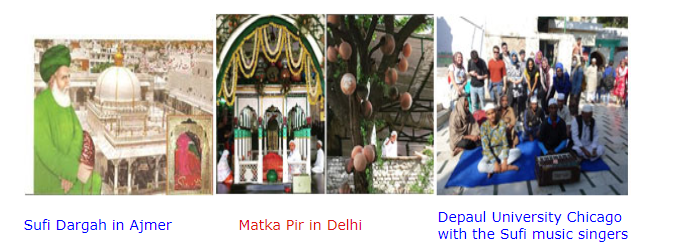
Who was Amir Khusrau? Poet par excellence – a saint, philosopher, mystic, and musician who wrote over 92 books. He wrote in prose and poetry in Arabic, Persian, Sanskrit, Turkish, and Indian dialects, such as Hindavi. He brought in qawwali – the Sufi music that is popular all over India. He lived to see the reign of seven kings of the Sultanate and served about four of them as a poet, courtier, officer and soldier. While mentioning such mystics we must remember their gurus- Shams Tabriz without whom Rumi would simply remain an erudite intellectual, and Hazrat Nizamuddin, without whom Amir Khusrau’s ecstatic vision would not have surfaced.
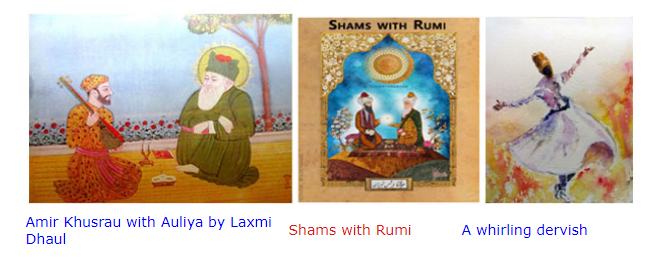
Once Auliya was grief-stricken over the death of his nephew Nooh Taqiuddin. He withdrew from the world and spent time at Nooh’s grave. Amir Khusrau tried hard to cheer him up but failed. One day Khusrau saw some people dancing, singing, dressed in yellow and celebrating the Basant festival. He too decided to do the same. After dressing in yellow he sang the qawwali, “Sakal basant aayo ri” (my friend Basant is here). Seeing his looks and attire, Auliya smiled for the first time after nearly six months.
Since then, every year for over seven centuries, Sufi Basant has become a regular festival of joy in Nizamuddin when devotees dress in yellow and offer marigold and mustard flowers to the Khwaja. In Islam, the colour yellow stands for wisdom. It’s a colour of happiness, warmth and sunshine with a strong spiritual significance in many cultures.
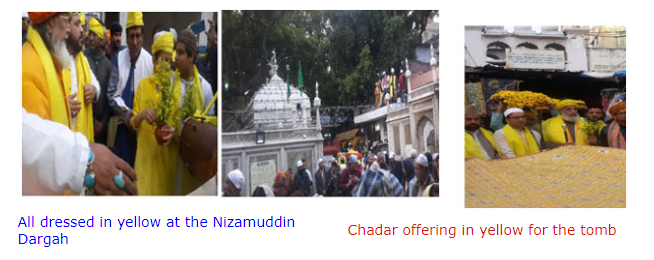
This year I had the joy of celebrating with a dear friend, Trudy. She was visiting from Gurgaon and was taken off-guard when I announced that we are off to Nizamuddin for Sufi Basant, she looked puzzled and knew this was another of Surekha’s surprises and the best way to enjoy is by going with the flow. Along the way with my walks visual aids she familiarized herself with Sufi Basant with me driving and making phone calls to figure out timings.
We arrived right on time to be part of the qawwali singing and took part in the procession of carrying the yellow chaddar. All dressed in yellow we too held part of the chaddar and walked with all the Khadims (caretakers) and qawwali singers – singing beautiful songs in praise of Basant and Auliya.
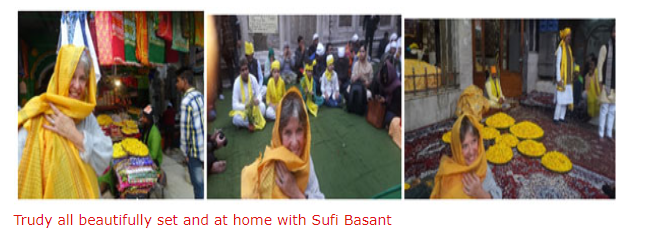
Sadly, for me, another farewell, as my dear friend has flown back to the UK because her husband’s three-year assignment in India is over. Miss her and all our lovely adventures.
“History shows that Qawwali was not just a form of performing art but a means to touch the unknown”, R. V. Smith, a veteran chronicler of Delhi.
With that we leave you with the words of Amir Khusrau for Sufi Basant.
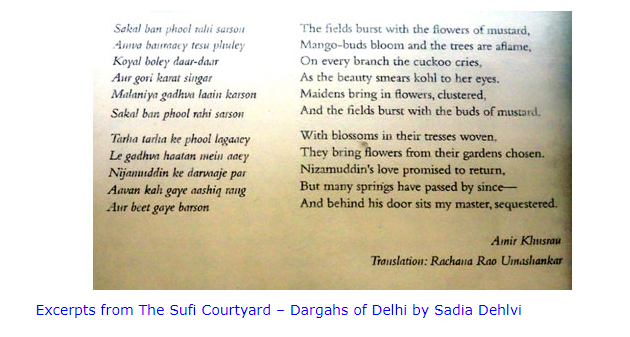
eritage walks with Surekha Narain. Contact details, +919811330098, surekha@delhimetrowalks.com and visit www.delhimetrowalks.com
Comments & Replies
Nayana Goradia in Delhi: Good to know how you are and how much valuable and useful information/ history you are providing to friends and well-wishers seeking only good wishes in return – typical Surekha. That is why we all u!
DMW: Thank you for you kind message Nayana! Nice to hear from you! It is fun to share information and it helps the dreary days of lockdown go by.
Marie in France: Thanks for sharing the blog link!
On 2nd Dec 2018, we were there together with Tamara and Gaby, walking through the mosque, the baoli, the gardens….Please see attached pictures.
I do remember the details of carved stones in the mosque, and the very special carving on to rooftop of the mosque!
Thanks for sharing your knowledge on these monuments and make it alive again through this blog! It recalls very nice memories of the Delhi Metro walks!
DMW: Yes my dear fond memories. This week more to come- remember the tragic death of Emperor Humayun and the amazing Sufi shrine. Thanks for sending the photos, tempted to replace the blog photo with yours.
Beverly in Delhi: Really enjoyed the first two parts of the blog on Purana Qila and look forward to doing this walk with you. I have been to the Sound and Light Show at Purana Qila but didn’t realise it is so fascinating to visit. The blog also reminded me of the walk I did with you in Nizamuddin, with such an interesting visit to the Hope Project. The story of Noor Inayat Khan is told in the book “Spy Princess”, which I had read years ago, and I was surprised to come across her again on a walk with Surekha! In this blog I have now learned more about her father. Thanks for sharing your research and insights.
DMW: Thank you Bev! The blogs are to provide an insight and enhance our knowledge of the places we know or have visited. Wait for what will unfold in Part 2! Spy Princess is a movie too and I plan to watch it soon. Curious to know if she was influenced by her father’s teaching and what made her a spy.